RSS
How Reuters and Getty Images Platform a Gaza Photojournalist Kissed by Hamas’ Sinwar

Yahya Sinwar, head of the Palestinian terror group Hamas in Gaza, in Gaza City on April 14, 2023. Photo: Yousef Masoud / SOPA Images/Sipa USA via Reuters Connect
On October 7, 2023, Gazan photojournalist Hassan Eslaiah held a grenade in one hand and a camera in the other, documenting Hamas’ massacre inside Israel. His exposure by HonestReporting, which brought to light a cozy photo of Eslaiah and former Hamas leader Yahya Sinwar, led to the end of his employment at CNN and the Associated Press.
Yet more than a year later, his work was still being offered for sale by Reuters and stock photo agency Getty Images, along with other compromised photojournalists in Gaza. (Getty only removed his work last week after an initial version of this story was published on HonestReporting’s website — and it remains available on Reuters).
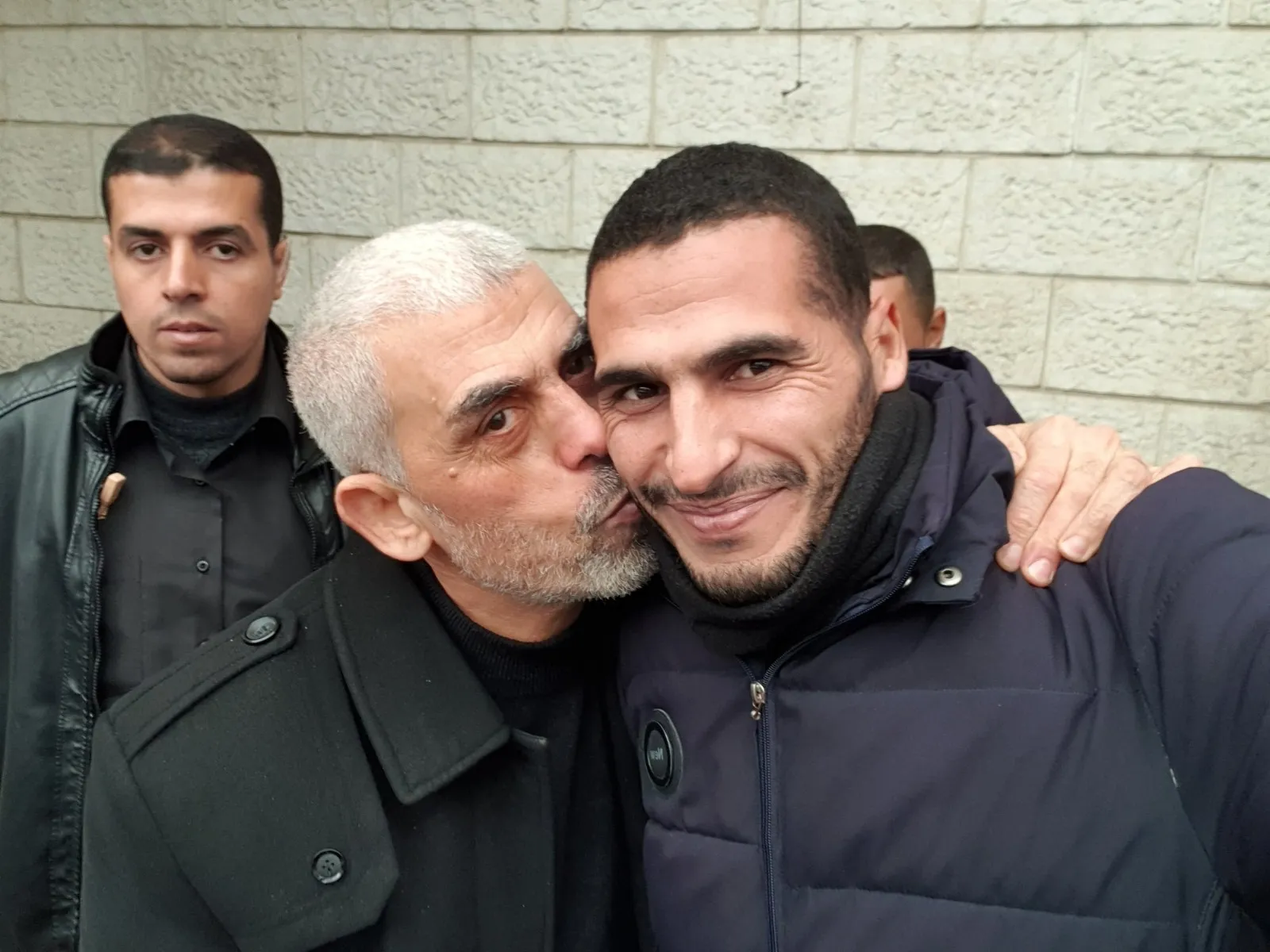
Hassan Eslaiah (r) with former Hamas leader Yahya Sinwar (l)
An HonestReporting investigation revealed that the two media companies have been distributing the tainted content in collaboration with state-run Turkish agency Anadolu — an arrangement that seems to enable their profit without liability. Both companies have a global reach, with Reuters as one of the world’s largest news agencies and US-based Getty Images as one of the world’s largest image licensing companies.
Their databases also present images by Anadolu freelancers Ashraf Amra and Mohammed Fayq Abu Mostafa, who Reuters officially distanced itself from after HonestReporting’s investigative team exposed Amra’s close relations with former Hamas leader Ismail Haniyeh, and his shared call with Abu Mostafa to invade Israel.
One of Abu Mostafa’s images, which is still for sale on the Reuters platform, has, according to Anadolu, been used as evidence in the genocide case against Israel at the International Court of Justice.
Unethical Content Distribution
Reuters partnered with Anadolu, which also collaborates with AFP and DPA to distribute its content, back in 2019. Reuters said that “these partnerships will help us create the most comprehensive collection of real-time, multimedia news content anywhere in the world.”
Anadolu’s partnership with Getty Images started in 2013, with Getty’s Senior Director of photography for Europe, the Middle East, and Africa saying at the time: “I am very excited at the prospect of seeing the Anadolu Agency represented by Getty Images around the world … I believe that the Anadolu Agency and Getty Images will benefit greatly from this partnership.”
Indeed, the partnership proved useful not only for the companies, but also for the compromised Gazan photojournalists who can no longer work directly for Western media.
Currently, Reuters offers for sale over 200 Anadolu photos by Hassan Eslaiah (spelled Hasan Eslayeh on their platforms). Most of the photos show Hamas’ hostage release ceremonies, including the barbaric handover of terrified Israeli hostage Arbel Yehud amid a mob of terrorists (which other Western media also picked up):
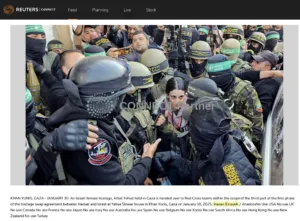
Eslaiah’s easy access and proximity to the action isn’t surprising. He enjoyed the same conditions on October 7, 2023 when he infiltrated with Hamas into Israel:
And here is footage of Eslaiah after he crossed into Israel and took photos of a burning Israeli tank. He then captured infiltrators entering Kibbutz Kfar Azza.
Note that he is not identifiable as a member of the press. But AP & CNN deemed it acceptable to use his services. pic.twitter.com/fA0VI2df2i
— HonestReporting (@HonestReporting) November 8, 2023
The fact that Eslaiah was fired from CNN and AP after we exposed him in November 2023 seems not to have affected his livelihood, with Reuters and Getty Images distributing his propagandist material under the cover of the partnership with Anadolu.
And until last week, Getty Images had no qualms about charging $175-499 dollars for each photo, presumably also including a cut for Anadolu and Eslaiah himself.
Reuters keeps the pricing confidential, but adds a disclaimer distancing itself from the content. The disclaimer seems like a cop-out because on its collaborations page, where Anadolu is listed, Reuters praises its partners’ “compelling content.”
In other words — Reuters and Getty Images make a profit, while abdicating responsibility for spreading the manipulative photos of a Hamas sympathizer, whose pockets are presumably also lined.
Platform for Manipulation
The same business model also seems to work for Gazan photojournalists Ashraf Amra and Mohammed Fayq Abu Mostafa. Reuters officially cut ties with them after we exposed in January 2024 that Amra was honored by former Hamas leader Ismail Haniyeh and hosted an Instagram Live with Abu Mostafa in which they called on Gazans to infiltrate into Israel on October 7.
Here’s Amra getting a kiss from Haniyeh in 2023 and receiving an honor from the unlamented Hamas leader in 2012. pic.twitter.com/VdWXN6wB32
— HonestReporting (@HonestReporting) February 23, 2025
But as Anadolu contributors, Amra and Abu Mostafa are both featured on the Reuters platform — Amra with over 5,000 photos and Abu Mostafa with over 300. On Getty, Amra is less prominent but over 150 photos of Abu Mostafa are offered for sale, including video clips.
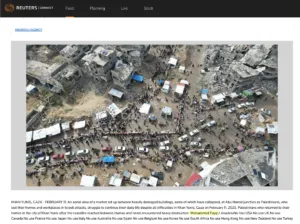
These photos don’t just sit in the databases. Reuters and Getty are among the world’s largest digital distribution platforms used by thousands of media clients worldwide.
Recently, Getty clients like The Times of London and the Daily Express were happy to buy Amra’s Anadolu photo showing the moment when Israeli hostage Omer Shem Tov “kissed” the head of his Hamas captor:
CNN did the same with Amra’s Anadolu photos of Israeli hostages Eli Sharabi and Or Levy via Getty Images.
And last year, Anadolu weaponized one of Abu Mostafa’s photos — still on sale in the Getty Images and Reuters platforms — as evidence at the ICJ case accusing Israel of committing a genocide against Palestinians in Gaza.
According to Anadolu, the photo “shows the mass burial of the Fatayer family members in a designated area in Gaza due to the lack of available space in some cemeteries.”
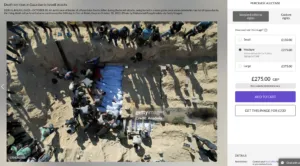
Fayq’s photo in Getty Images database
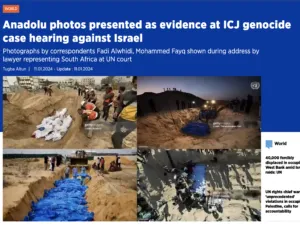
Fayq’s Photo in Anadolu website

Fayq’s Photo in Reuters Database
Sadly, the court didn’t know the photo was taken by a “journalist” who was thrilled by the massacre of Jews and called on Gazans to infiltrate the border, to enjoy the abduction of “settler” women.
But more Reuters and Getty’s own responses, it may be time for US Attorney General Pam Bondi to take an interest. In December 2023, following HonestReporting’s exposure of photojournalists who infiltrated Israel on October 7, 14 state attorneys general wrote a letter to The New York Times, AP, CNN, and Reuters calling them out for using hires with ties to Hamas and reminding them that providing material support to terrorists and terror organizations is a crime.
The letter even specifically mentions the case of Hasan Eslaiah and ends by calling on the media outlets to “ensure that you are taking all necessary steps to prevent your organizations from contracting with members of terror organizations. We urge you in the strongest terms to take care that your hiring practices conform to the laws forbidding material support for terror organizations.”
Despite whatever action may be taken, these propagandists have found a deceitful way to continue spreading their lies to the international media.
And the international media can, for at least the time being, enjoy the “goods” without getting their hands dirty.
UPDATE
Within a few hours of publication of this article on HonestReporting’s website, Getty Images, to their credit, removed all content that was flagged by HonestReporting, including a Ramzi Adel video that called Jews “dogs,” and content from Hassan Eslaiah, Ashraf Amra, and Mohammed Fayq Abu Mostafa.
The same cannot be said for Reuters, however, which gave us the following statement referring to the Connect platform it operates: “Reuters Connect is a commercial marketplace with content from more than 100 news organizations, allowing media customers the option to select the content that is most relevant to their news cycle. This content is clearly labeled and is not endorsed by Reuters.”
HonestReporting is a Jerusalem-based media watchdog with a focus on antisemitism and anti-Israel bias — where a version of this article first appeared.
The post How Reuters and Getty Images Platform a Gaza Photojournalist Kissed by Hamas’ Sinwar first appeared on Algemeiner.com.
RSS
After False Dawns, Gazans Hope Trump Will Force End to Two-Year-Old War

Palestinians walk past a residential building destroyed in previous Israeli strikes, after Hamas agreed to release hostages and accept some other terms in a US plan to end the war, in Nuseirat, central Gaza Strip October 4, 2025. Photo: REUTERS/Mahmoud Issa
Exhausted Palestinians in Gaza clung to hopes on Saturday that US President Donald Trump would keep up pressure on Israel to end a two-year-old war that has killed tens of thousands and displaced the entire population of more than two million.
Hamas’ declaration that it was ready to hand over hostages and accept some terms of Trump’s plan to end the conflict while calling for more talks on several key issues was greeted with relief in the enclave, where most homes are now in ruins.
“It’s happy news, it saves those who are still alive,” said 32-year-old Saoud Qarneyta, reacting to Hamas’ response and Trump’s intervention. “This is enough. Houses have been damaged, everything has been damaged, what is left? Nothing.”
GAZAN RESIDENT HOPES ‘WE WILL BE DONE WITH WARS’
Ismail Zayda, 40, a father of three, displaced from a suburb in northern Gaza City where Israel launched a full-scale ground operation last month, said: “We want President Trump to keep pushing for an end to the war, if this chance is lost, it means that Gaza City will be destroyed by Israel and we might not survive.
“Enough, two years of bombardment, death and starvation. Enough,” he told Reuters on a social media chat.
“God willing this will be the last war. We will hopefully be done with the wars,” said 59-year-old Ali Ahmad, speaking in one of the tented camps where most Palestinians now live.
“We urge all sides not to backtrack. Every day of delay costs lives in Gaza, it is not just time wasted, lives get wasted too,” said Tamer Al-Burai, a Gaza City businessman displaced with members of his family in central Gaza Strip.
After two previous ceasefires — one near the start of the war and another earlier this year — lasted only a few weeks, he said; “I am very optimistic this time, maybe Trump’s seeking to be remembered as a man of peace, will bring us real peace this time.”
RESIDENT WORRIES THAT NETANYAHU WILL ‘SABOTAGE’ DEAL
Some voiced hopes of returning to their homes, but the Israeli military issued a fresh warning to Gazans on Saturday to stay out of Gaza City, describing it as a “dangerous combat zone.”
Gazans have faced previous false dawns during the past two years, when Trump and others declared at several points during on-off negotiations between Hamas, Israel and Arab and US mediators that a deal was close, only for war to rage on.
“Will it happen? Can we trust Trump? Maybe we trust Trump, but will Netanyahu abide this time? He has always sabotaged everything and continued the war. I hope he ends it now,” said Aya, 31, who was displaced with her family to Deir Al-Balah in the central Gaza Strip.
She added: “Maybe there is a chance the war ends at October 7, two years after it began.”
RSS
Mass Rally in Rome on Fourth Day of Italy’s Pro-Palestinian Protests

A Pro-Palestinian demonstrator waves a Palestinian flag during a national protest for Gaza in Rome, Italy, October 4, 2025. Photo: REUTERS/Claudia Greco
Large crowds assembled in central Rome on Saturday for the fourth straight day of protests in Italy since Israel intercepted an international flotilla trying to deliver aid to Gaza, and detained its activists.
People holding banners and Palestinian flags, chanting “Free Palestine” and other slogans, filed past the Colosseum, taking part in a march that organizers hoped would attract at least 1 million people.
“I’m here with a lot of other friends because I think it is important for us all to mobilize individually,” Francesco Galtieri, a 65-year-old musician from Rome, said. “If we don’t all mobilize, then nothing will change.”
Since Israel started blocking the flotilla late on Wednesday, protests have sprung up across Europe and in other parts of the world, but in Italy they have been a daily occurrence, in multiple cities.
On Friday, unions called a general strike in support of the flotilla, with demonstrations across the country that attracted more than 2 million, according to organizers. The interior ministry estimated attendance at around 400,000.
Italy’s right-wing government has been critical of the protests, with Prime Minister Giorgia Meloni suggesting that people would skip work for Gaza just as an excuse for a longer weekend break.
On Saturday, Meloni blamed protesters for insulting graffiti that appeared on a statue of the late Pope John Paul II outside Rome’s main train station, where Pro-Palestinian groups have been holding a protest picket.
“They say they are taking to the streets for peace, but then they insult the memory of a man who was a true defender and builder of peace. A shameful act committed by people blinded by ideology,” she said in a statement.
Israel launched its Gaza offensive after Hamas terrorists staged a cross border attack on October 7, 2023, killing some 1,200 people and taking 251 people hostage.
RSS
Hamas Says It Agrees to Release All Israeli Hostages Under Trump Gaza Plan

Smoke rises during an Israeli military operation in Gaza City, as seen from the central Gaza Strip, October 2, 2025. Photo: REUTERS/Dawoud Abu Alkas
Hamas said on Friday it had agreed to release all Israeli hostages, alive or dead, under the terms of US President Donald Trump’s Gaza proposal, and signaled readiness to immediately enter mediated negotiations to discuss the details.


